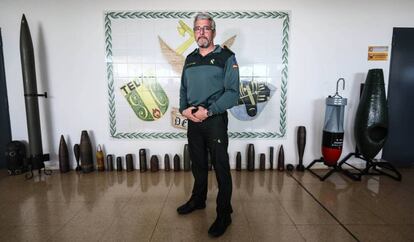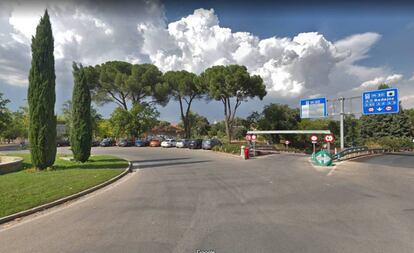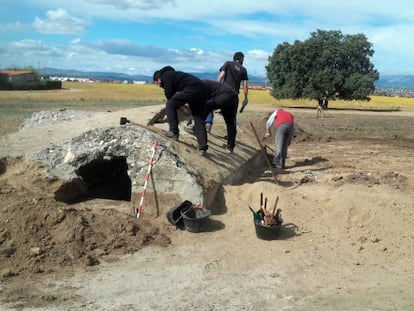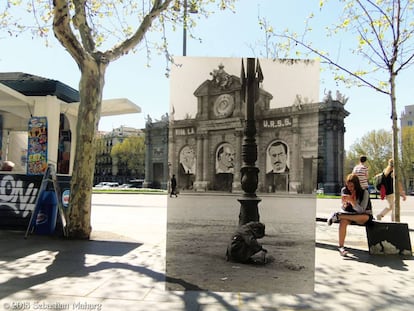The most explosive legacy of the Spanish Civil War
Today marks 80 years since the end of the conflict, but the authorities continue to make more than a thousand unexploded bombs and other devices safe every year
CIVIL WAR ARTIFACTS FOUND SINCE 1985
Click on the red points to find out how many bombs have been found in each municipality
Today marks the 80th anniversary of the end of the Spanish Civil War (1936-1939). Yet for all the years that have gone by, explosive devices continue to turn up across the country: as many as a thousand are neutralized each year by bomb-disposal experts.
On March 21, National Police technicians dismantled a 45-centimeter projectile that turned up during roadworks in Madrid’s Casa de Campo, a large public park where thousands of locals go every weekend. The perimeter around the unexploded device was closed off and two nearby buildings were evacuated.
In March 1985, a fishing boat dragged two World War I bombs out of the Bay of Biscay
This was not an unusual event. Just four days earlier, another shell had turned up near the School of Architecture at Madrid’s Polytechnic University. This is no coincidence: one of the frontlines of the Civil War ran through the university campus and the Casa de Campo.
The tens of thousands of unexploded devices left behind by the three-year conflict haven’t lost a single particle of their destructive power, despite the decades that have elapsed.
“If the projectile opens up, the explosives can end up damaged by moisture, but if it is intact, it remains indefinitely active,” warns Lieutenant Salvador Serrano, of the Civil Guard’s bomb disposal squad based at Valdemoro (Madrid).
On May 2, 2018 a 38-year-old man was seriously injured by a projectile that he’d been keeping inside his house in Arévalo (Ávila). When the neighbors alerted the Civil Guard, the latter found an entire arsenal from the Civil War stored on the premises.

And in November 2014, a farmer died in Vila-real (Castellón) when a Civil War bomb went off inside his tool shed. In September 2013, a man and his son were seriously injured when a device went off inside a garage they were cleaning out in Teruel.
According to a reply to a parliamentary information request from Senator Jon Iñarritu of the EH Bildu party, the Civil Guard has dismantled around 35,000 explosive devices since 1985, and 80% of these were Civil War weapons.
The map showing the locations of the bombs, based on a 300-page list of findings, evidences the spots where the war’s major battles were fought: Jarama, Guadalajara, Brunete, Teruel, Ebro... No Spanish province is entirely free of this potential danger, but some places are safer than others. Teruel ranks first for the sheer number of devices found (3,693), followed by Asturias (2,283), Madrid (2,277), Tarragona (2,194) and Castellón (2,058).

Contrary to what one might presume, the number of findings has not decreased with time. Instead, the figure has remained stable at around 1,000 a year, with sporadic peaks such as the time when 538 grenades were found inside an aquifer in Teruel, in July 2017. Numerous devices have also turned up on former battlegrounds that were dug up during the real estate boom in Spain.
According to Lieutenant Serrano, most of the findings in rural areas are made by hikers or shepherds following a rainstorm that exposes the devices. In the cities, the bombs typically turn up when bulldozers dig up the earth for construction purposes. But projectiles have also been found inside homes, sandwiched in under false ceilings or between the walls, as if the homeowners had been storing them for use in case of an attack.
But the greatest danger comes from collectors who take these items home, sometimes without even being aware of their deadly charge, Even a broken, seemingly empty shell, which some people use as a flower vase, could still contain traces of gunpowder.
Danger: do not touch
The Civil Guard keeps insisting that anyone who finds what looks like an explosive device should not touch it, much less transport it. Instead, they should mark the spot with some kind of sign, and call 062. Technicians will then attempt to destroy it on the spot, or at the nearest safe place.
The most numerous devices to have turned up are hand grenades (13,219), followed by artillery shells (12,959), mortar grenades (6,080), and fuzes (1,267). The lowest figure, 645, is for aviation bombs, either Italian or German. These artifacts, however, are the deadliest: 75% of their weight is TNT.
In early March, a Civil Guard explosives technician named Eusebio Rodríguez, 36, was sent out to Loranca de Tajuña (Guadalajara) because a local resident had found a grenade. He remembers turning pale when this man explained that the artifact must have a loose piece somewhere inside, because it made a sound when shaken. He could have easily been blown to bits.
Occasionally, even older weapons turn up. In March 1985, a fishing boat dragged two World War I bombs out of the Bay of Biscay and took them to port. When experts began dismantling the first one, it emitted a gas that sent one officer to the hospital for four days. It was a chemical bomb. Fortunately it was raining at the time and the toxic cloud did not spread. The second bomb was tossed right back into a deep-sea canyon.
English version by Susana Urra.
Tu suscripción se está usando en otro dispositivo
¿Quieres añadir otro usuario a tu suscripción?
Si continúas leyendo en este dispositivo, no se podrá leer en el otro.
FlechaTu suscripción se está usando en otro dispositivo y solo puedes acceder a EL PAÍS desde un dispositivo a la vez.
Si quieres compartir tu cuenta, cambia tu suscripción a la modalidad Premium, así podrás añadir otro usuario. Cada uno accederá con su propia cuenta de email, lo que os permitirá personalizar vuestra experiencia en EL PAÍS.
¿Tienes una suscripción de empresa? Accede aquí para contratar más cuentas.
En el caso de no saber quién está usando tu cuenta, te recomendamos cambiar tu contraseña aquí.
Si decides continuar compartiendo tu cuenta, este mensaje se mostrará en tu dispositivo y en el de la otra persona que está usando tu cuenta de forma indefinida, afectando a tu experiencia de lectura. Puedes consultar aquí los términos y condiciones de la suscripción digital.
More information
Archived In
Últimas noticias
Most viewed
- Pablo Escobar’s hippos: A serious environmental problem, 40 years on
- Reinhard Genzel, Nobel laureate in physics: ‘One-minute videos will never give you the truth’
- Why we lost the habit of sleeping in two segments and how that changed our sense of time
- Charles Dubouloz, mountaineering star, retires at 36 with a farewell tour inspired by Walter Bonatti
- The Florida Keys tourist paradise is besieged by immigration agents: ‘We’ve never seen anything like this’










































